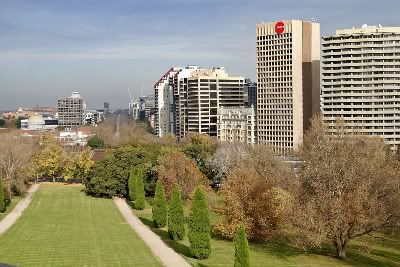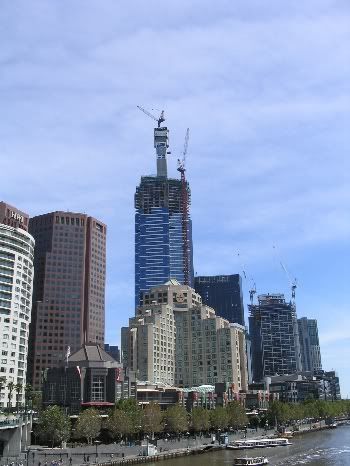Imperium (city)
| Imperium | |

| |
|---|---|
| Population | 47,689,232 |
| District(s) | Capital Asbury |
| County | George |
| Province | New Britain |
| Country | United Kingdom |
| Post Town | Imperium |
| Postal Code | WB, EB, NF, S, SE, E, NE |
| Parliament District | Asbury Southend |
The city of Imperium rests upon the New Thames River on the island of New Britain and serves as the capital for both the Province of New Britain as well as the whole of the United Kingdom. The large urban metropolis boasts a population of over 47 million people in its immediate environs with a further 23 living outside the city along the banks of the New Thames, primarily in the southern direction as routes to the north and west are blocked by mountains.
Imperium holds the honour of being the seat of Parliament for the whole of the United Kingdom, and as such is the centre of national Azazian politics. Additionally, the monarchy maintains a palace and several mansions within the city limits, although the primary residence has been shifting to a mountain retreat on the northern fringes of the Imperium metropolis.
History
The site of modern day Imperium once boasted a small inlet for a tributary that afforded English explorers a safe location in which they could spend the night – and consequently beginning sending out expeditions from their troop ships. At the sight of the confluence the English settlers founded a village called Georgetown. From Georgetown the rapid influx of English immigrants moved northwards founding the then-independent towns of Bradbury, North Chester, Fordsbury, and Franklin.
As English expansion continued at the expense of the native Azazian Empire, the native Azazians took to sailing up the New Thames River at night and raiding Georgetown with its lack of permanent defences. The raids became so devastating that a royal governor was kidnapped and held hostage before his ransom was paid. This act precipitated the shift of development to the more defensible east bank, where upon a small hill the settlers erected mansions for the royal governor, the mayor, and the military office in charge of defence. These structures were then contained within a heavily fortified brick structure that became known as the Citadel. Although changes have been made over the centuries, the Citadel remains the seat of power for the island of New Britain, and now the whole United Kingdom.
 Looking to the East from inside the Citadel | |
|---|---|
 The Colonial Bank Centre in the Asbury Financial District | |
|---|---|
With the discovery of small deposits of iron and silver in the mountains to the west, the city began to ship its iron westward towards the newly founded port of St. Brendans, where deposits of coal made the establishment of iron and later steel industries not only feasible, but economically profitable. From this point onwards, in part due to the burgeoning economic success of St. Brendans and later towns such as Philadelphia, Portsmouth, and Artega, the city of Georgetown declined in economic importance.
Throughout the nineteenth century, the city of Georgetown grew in direct competition as a banking centre. While St. Brendans featured national and regional banks, Georgetown’s financial importance grew as England dispatched capital to be invested in her colony and while the newer foreign colonies of Amsterdam, Paris, and Moscow sought trade with the profitable English colony, a colony in which they could only gain access through Georgetown.
The state of affairs continued as such with development progressing rapidly in addition to the continuing influx of immigrants. The elaborate rail system of the United Kingdom also found its foundations in these earlier days as the first rail route was established between Georgetown and Clifton Heights, from which the ores mined to the west of Georgetown and in the silver-mining town appropriately named Silverton were dispatched by cargo ship to St. Brendans only two days distant by steam-powered ship. Roads grew in importance as did the maritime transit network that allowed for rapid communication and transit between Georgetown and the cities further south along the New Thames and along the coastline of New Britain and New Australia.
In the twentieth century, however, Georgetown would change forever. Shortly after receiving independence from Great Britain prior to World War I, the new capital of Brittany, the original name of the newly formed country arising out of the English colonies, found itself home to delegates of the other colonies that took independence during the First World War. These states all banded together to form the Commonwealth of Azazia, a loose affiliation of republics and monarchies that held their meetings in Georgetown. However, as the islands increasingly found themselves unifying, the Russian peoples, by far the most repressed and economically depressed, set off a brutal revolution that swept through the whole of the Azazian Archipelago. With lightening speed they managed to raid, and burn most of Georgetown while the Royal Navy was off the coast of Philadelphia engaging a diversionary force. After three years of bitter, bloody fighting, the Russians managed to impose Russification upon the Commonwealth.
Russification meant the abandonment of many Anglo names throughout the country. Among them the name of the English monarchy that had become de facto head of state. From the Barent family they became the Barins, John became Ivan and Michael became Mikhail. The city of St. Brendans – captured in an early raid – was forced to change its name to Breningrad while Georgetown suffered humiliation in the initial discussions as its new proposed name would be New Moscow. However, while negotiations were in session, the city of Regal was recaptured and the tide appeared to be slowly shifting away from the initial Russian victories and towards the English conquest of all Russian territories. The Russians admitted defeat and met the English with the compromise name of Imperium, the city named for the centre of the empire that was the Commonwealth.
Although the city has since also suffered lightly from the revolt by the native Azazians, Imperium found itself stuck with the name and the legacy as the seat of power throughout the Commonwealth. During the intervening years, the burned rubble of the city allowed for massive improvements to be made to the city’s infrastructure. The city granted wide swaths of land for new railroad, subways, and monorails in addition to massive superhighways and heliports. The rebirth of Georgetown in the guise of Imperium allowed for the restructuring of the country’s capital. The population rapidly grew until the 21st century where the rate of increase has slowed leaving the current population of some 47 million.
Geography
 I - Fordsbury II - Nimberhead | |
|---|---|
Imperium is located south of the headwaters of the New Thames River at the first cataract, a minor waterfall of two meters and the site of the modern Citadel. Geologically, the city was built atop the remains of the Georgetown Plateau, the remnants of a large highland extending south from the Brittany Mountain Range, most of which has since been absorbed by the Pacific. The Westbank District, situated on the western bank of the New Thames rests upon the piedmont of the Brittany Mountain Range, once the focus of a convergent zone between the small Belden Continental Plate and the far more massive Azazian Plate.
The New Thames River was gouged out of the highlands as the last glaciers retreated up into the New Brittany Mountains, carving a deep valley that is now filled by the large aquifer underneath the island of New Britain and fueled in the spring and summer months by the annual melt of the large quantities of snow that fall upon the Range’s higher elevations.
The map of New Britain to the left shows the relative position of Imperium (the flat and slightly muddy crimson shape along the New Thames) in relative position to the urban and human geography of New Britain. Although light in detail, the barely visible redlines indicate the main rail routes that cross the island – each servicing upwards of eight tracks for the heavy commuter and freight traffic entering and leaving Imperium on a daily basis.
The numbers indicate the important communities and cities on New Britain and their relationship to Imperium, although this is far from being conclusive with major cities such as Arleshire and Dansbury being left off. However, despite the location of Imperium on the New Thames and its status as an inland port, it remains dependent on the deeper ports of cities such as Churchill and North Shores.
Governance
The Imperium Council governs the city of Imperium including the eight political districts, devised to ease the strain on electoral logistics. At the head of the council is the Lord Mayor of Imperium, currently Sir John Williams, who represents the interests of the nation’s capital city while attending domestic political affairs but is tasked with the duty of representing both the immediate environs and the suburbs to international representatives visiting the UK and while abroad.
Internally, the city of Imperium is divided into eight districts: the Capital, Asbury, Southend, Westbank, New Collinsdale, Crohill, Northshore, and Newport. The Capital is the oldest and constitutes the Citadel and the immediate area, including most government ministries, while Newport is the youngest and includes the new port facilities towards the south of the city where the New Thames begins to widen. Given the immense size of the city, each district elects twenty-five councilors to represent them in the Imperium Council, giving the city a legislative body a total of 200 members.
The economic, cultural, and sheer demographic dominance of the capital city ensures that “what’s good for Imperium is good for New Britain.” As such, the Republic of New Britain spends most of its budget dealing with affairs in Imperium such as maintaining the expansive mass-transit system as well as the power-grid and critical information and telecommunication infrastructure. In recent years this has caused public outcries, especially from citizens of the cities such as Churchill and North Shores, both cities of over five million denizens.
Economy
 Riverfront development in New Collinsdale | |
|---|---|
Imperium remains an important hub of for banking and financial services throughout the Pacific region. Although the cities of Philadelphia and Breningrad have eclipsed the capital in terms of primacy in that sector, the most important intangible asset for Imperium continues to be its status as the political capital of the United Kingdom, and as such one of the most frequented ports of entry to the United Kingdom via air travel.
With the continuing decline of the manufacturing sector in the United Kingdom (see Economy of Azazia) the city has benefited from a reduction in the kilograms of pollution produced per capita, and as such the city has seen an influx of bio-technology firms and environmentally-based companies that seek to capitalise on the potential for a materially-based green economy; although contemporary economists and theorists debate the viability of such a radically new model for a traditionally neo-classically driven city historically more concerned with maximizing the industrial output to challenge its western competitors, mainly Breningrad and Philadelphia.
Following the bio-tech and green industries are numerous service industries, including many legal services given the highly political and diplomatic nature of the town. Also included in the service industry are the numerous transportation companies that make Imperium their headquarters given the importance of the city as a hub of transit for the eastern islands of the UK.
While most of the “old money” in Imperium remains committed to the various commercial cores such as the Asbury Financial District or the Southend’s Wharf Market, the “new money” in the fields of bio- and information-technology is to be found developing the once dilapidated district of New Collinsdale. These companies have of course taken the environment as the UK market increasingly demands more conservation, and when coupled with the tax incentives provided by Parliament, the Imperium commercial sector invests heavily in earth-friendly buildings and infrastructures, which is only raising the real estate value in the city in a development that will likely reap benefits for Imperium’s economy.
Demographics
As is the case with most of the UK’s eastern islands, the city of Imperium enjoys a greater degree of wealth than the western portions of the country and so the GDP per capita of an average citizen in the city is nearly $6,000 (USD) higher than the national average. The result of such concentrated wealth is the displacement of the poor and working classes to the cities and towns on the outskirts of the capital, straining their local resources, and thus enforcing the popular distinction of Imperium as a city for the wealthy elite.
See Also
| Cities in the United Kingdom and Oceanic Empire |
|---|
| Global Cities Imperium | Philadelphia |
| National Cities Poldi'sk | Port Hamptonshire | Queensbury |
| Regional Cities Charlotte | Churchill | Invercardon | Kingston | Salisbury | Zvolen |
